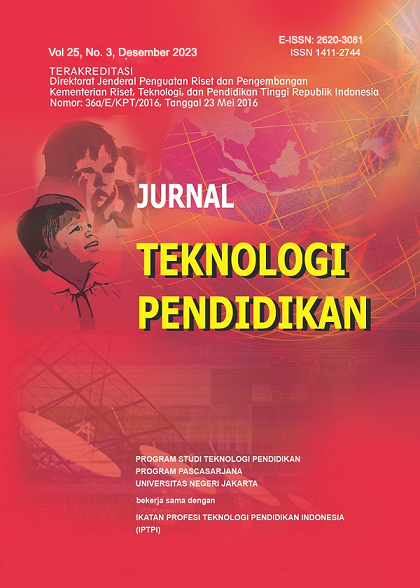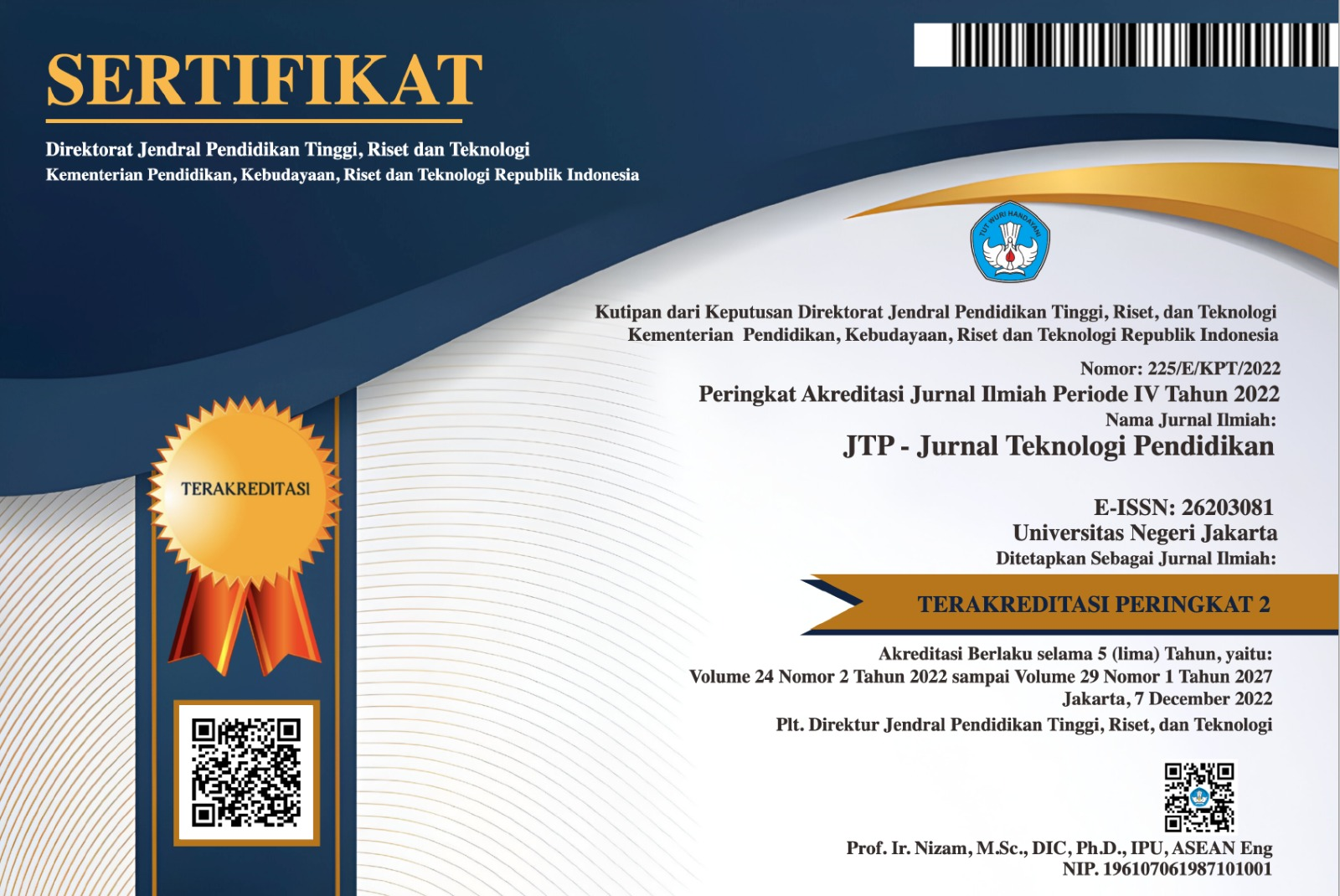Development of Characterized Digital Comics for Junior High School Students in Social Studies Learning
DOI:
https://doi.org/10.21009/jtp.v25i3.38946Keywords:
Digital Comics, Characters for Junior High School Students, Learning MediaAbstract
This study is aimed at developing the material for social science study at Junior High School by using characterized digital comics. The study uses a research and development model popularized by Borg and Gall. The types of data used in this research are qualitative and quantitative data. Qualitative data was obtained based on criticism and suggestions for improvement from validators. Quantitative data was obtained based on the results of filling out a questionnaire in the form of objective product assessment scores. The instruments used for data collection were open and closed questionnaires. Based on the results of data analysis from media experts, a feasibility value was obtained from media experts 149 a maximum value of 152 so that a percentage of 98% was obtained, from material experts a feasibility value was obtained of 112 from a maximum value of 114 so that a percentage of 98% was obtained, and the results of scale group trials limited (10 students) obtained a score of 890 out of a total of 1000 so that a percentage of 89% was obtained. This shows that the digital comic with characters being developed is classified as "very valid" and can be implemented. In brief, the results of developing digital comics with characters are appropriate and can be recommended to be used in social science studies at junior high schools.
References
Akbar, Sa’dun & Sriwiyana, Hadi. (2011). Pengembangan Kurikulum dan Pembelajaran Ilmu Pengetahuan Sosial. Yogyakarta: Cipta Media.
Ardhana, Wayan. (2002). Konsep Penelitian Pengembangan dalam Bidang Pendidikan dan Pembelajaran. Malang. Universitas Negeri Malang.
Arikunto, Suharsimi. (2010). Prosedur Penelitian: Suatu Pendekatan Praktik. Jakarta: Rineka Cipta.
Banks, J. (1990). Teaching Strategies for the Social Studies: Inquiry, Valuing, and Decision Making. New Yor: Longman.
Bolton, Chynthia & Gary. (2012). Connecting Through Comics: Expanding Opportunities For Teaching And Learning. Diakses pada 5 April 2018 http://www.comicstripcreator.org/files/papers/DigitalHypermediaComics.pdf.
Borg, W. & Gall, M. (1983). Educational Research: An Introduction 4th Edition. New York. Longman Inc.
Bro, P., & Wallberg, F. (2015). Gatekeeping in a digital era: Principles, practices and technological platforms. Journalism Practice, 9(1), 92–105. https://doi.org/10.1080/17512786.2014.928468
Buckingham, D. (2007). Media education goes digital: An introduction. Learning, Media and Technology, 32(2), 111–119. https://doi.org/10.1080/17439880701343006
Calafato, R., & Gudim, F. (2022). Comics as a multimodal resource and students’ willingness to communicate in Russian. Journal of Graphic Novels and Comics, 13(2), 270–286. https://doi.org/10.1080/21504857.2021.1951788
Dahlan, M. A. (1995). Information, Technology, and Society. Media Asia, 22(3), 128–131. https://doi.org/10.1080/01296612.1995.11726472.
Darmiyati, Zuchdi. 2013. Model Pendidikan Karakter. Yogyakarta: UNY Press.
Fadel, C., & Trilling, B. (2010). 21st Century Skills: Learning for Life in Our Times. Education Review. Education Review.
Jarolimek, J. (1986). Social studies in elementary education. New York: Macmillan.
Javed, M. S., Athar, M. R., & Saboor, A. (2019). Development of a twenty-first century skills scale for agri varsities. Cogent Business and Management, 6(1), 1–23. https://doi.org/10.1080/23311975.2019.1692485.
Kemdiknas. (1966). Konsep pendidikan sistem ganda pada sekolah menengah kejuruan di Indonesia. Jakarta: Depdiknas.
Maftuh, B. (2010). Memperkuat Peran IPS dalam Membelajarkan Keterampilan Sosial dan Resolusi Konflik. Pidato Pengukuhan Jabatan Guru Besar dalam bidang Pendidikan Ilmu Pengetahuan Sosial Pada FPIPS UPI. Bandung: FPIPS UPI.
Mamolo, L. A. (2019). Development of digital interactive math comics (DIMaC) for senior high school students in general mathematics. Cogent Education, 6(1). https://doi.org/10.1080/2331186X.2019.1689639.
Michael Boloudakis, From Digitized Comic Books To Digital Hypermedia Comic Books: Their Use In Education. Diakses pada 5 April 2018 https://files.eric.ed.gov/fulltext/ED533545.pdf.
Mok, M. M. C. (2021). Learning, education and collaboration with the support of digital technology. Educational Psychology, 41(1), 1–4. https://doi.org/10.1080/01443410.2021.1866818.
Munir. (2017). Pembelajaran Digital. Bandung: Alfabeta.
Ozdemi, Ertugrul. (2010). The Effect Of Instructional Comics On Sixth Grade Students’ Achievement In Heat Transfer. Diakses pada 5 April 2018 https://www.researchgate.net/profile/Ertugrul_Ozdemir/publication/3199 03513_The_Effect_of_Instructional_Comics_on_Sixth_Grade_Students’_Achievement_in_Heat_Transfer/links/5a464bb30f7e9ba868aa24b7/The-Effect-of-Instructional-Comics-on-Sixth-Grade-Students-Achievement-in-Heat-Transfer.pdf.
P, Grifin; & E, Care. (2015). Assessment and Teaching of 21st Century Skills: Methods and Approach.
Piirto, J. (2011). Creativity for 21st Century Skills: How to Embed Creativity into the Curriculum. Rotterdam: Sense Publishers.
Pijnaker, T., & Spronk, R. (2017). Africa’s Legends : digital technologies, aesthetics and middle-class aspirations in Ghanaian games and comics . Critical African Studies, 9(3), 327–349. https://doi.org/10.1080/21681392.2017.1371617.
Sudjana, N dan Rivai. (2008). Media Pengajaran. Bandung: Sinar Baru Algensindo.
Supriatna, N. (2020). Pedagogi Kreatif Menumbuhkan Kreativitas dalam Pembelajaran Sejarah dan IPS. Bandung: Remaja Rosdakarya.
Syarbini, Amirullah. 2012. Buku Pintar Pendidikan Karakter. Jakarta: as@- Prima Pustaka.
Widodo, A., Indraswasti, D., Erfan, M., Maulyda, A. M., & Rahmatih, N. A. (2020). Profil minat baca mahasiswa baru PGSD Universitas Mataram., 10(1), 34–48. (Vol. 10). Premiere Educandum: Jurnal Pendidikan Dasar Dan Pembelajaran.
Woolever, R. M. (1988). Active learning in social studies: promoting cognitive and social growth. United States: Scott, Foresman/Little, Brown College Division.
Vassilikopoulou, M., Retalisa, S., Nezi, M., & Boloudakis, M. (2011). Pilot use of digital educational comics in language teaching. Educational Media International, 48(2), 115–126. https://doi.org/10.1080/09523987.2011.576522.
Downloads
Published
How to Cite
Issue
Section
License
Jurnal Teknologi Pendidikan is an Open Access Journal. The authors who publish the manuscript in Jurnal Teknologi Pendidikan agree to the following terms.
Attribution-ShareAlike 4.0 International (CC BY-SA 4.0)
-
Attribution — You must give appropriate credit, provide a link to the license, and indicate if changes were made. You may do so in any reasonable manner, but not in any way that suggests the licensor endorses you or your use.
-
ShareAlike — If you remix, transform, or build upon the material, you must distribute your contributions under the same license as the original.
- No additional restrictions — You may not apply legal terms or technological measures that legally restrict others from doing anything the license permits.
Notices:
- You do not have to comply with the license for elements of the material in the public domain or where your use is permitted by an applicable exception or limitation.
- No warranties are given. The license may not give you all of the permissions necessary for your intended use. For example, other rights such as publicity, privacy, or moral rights may limit how you use the material.








